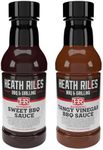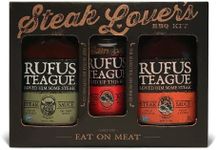Buying Guide for the Best Barbeque Sauces
Choosing the right barbecue sauce can elevate your grilling experience and add a burst of flavor to your dishes. The perfect sauce for you will depend on your taste preferences, the type of meat you're cooking, and the style of barbecue you enjoy. Here are some key specifications to consider when selecting a barbecue sauce, along with explanations to help you make an informed decision.Flavor ProfileThe flavor profile of a barbecue sauce is a combination of its taste elements, such as sweet, tangy, spicy, and smoky. This is important because it determines the overall taste experience. Sweet sauces often contain ingredients like molasses or brown sugar and are great for pork or chicken. Tangy sauces, which include vinegar, are popular in Carolina-style barbecue and pair well with pulled pork. Spicy sauces have a kick from ingredients like chili peppers and are perfect for those who enjoy heat. Smoky sauces often include liquid smoke or smoked ingredients and are ideal for adding a rich, deep flavor to beef or ribs. Choose a flavor profile that complements your taste preferences and the type of meat you're cooking.
ConsistencyConsistency refers to the thickness of the barbecue sauce. This is important because it affects how the sauce adheres to the meat and how it cooks. Thin sauces are more like marinades and are great for basting and adding layers of flavor during cooking. Medium-consistency sauces are versatile and can be used for both basting and as a finishing sauce. Thick sauces are best for brushing on at the end of cooking or serving as a dipping sauce. Consider how you plan to use the sauce and choose a consistency that matches your cooking method.
IngredientsThe ingredients in a barbecue sauce can vary widely and impact both flavor and dietary preferences. Common ingredients include tomatoes, vinegar, sugar, spices, and various flavorings. If you have dietary restrictions or preferences, such as avoiding high-fructose corn syrup, gluten, or artificial additives, check the ingredient list carefully. Additionally, some sauces may include unique ingredients like fruit, whiskey, or coffee for a distinctive taste. Choose a sauce with ingredients that align with your dietary needs and flavor preferences.
Regional StyleBarbecue sauces often reflect the regional styles of barbecue, each with its own unique characteristics. For example, Kansas City-style sauces are typically thick, sweet, and tomato-based, while Texas-style sauces are thinner, spicier, and may include a smoky flavor. Carolina-style sauces are vinegar-based and tangy, and Alabama white sauce is a mayonnaise-based sauce with a tangy flavor. Understanding these regional differences can help you choose a sauce that matches the style of barbecue you enjoy. If you're unsure, try a few different styles to see which one you prefer.
Heat LevelThe heat level of a barbecue sauce refers to its spiciness, which is important for those who enjoy a bit of a kick in their food. Heat levels can range from mild to very hot, depending on the type and amount of chili peppers used. Mild sauces are suitable for those who prefer a subtle warmth, while medium sauces offer a balanced heat that complements the other flavors. Hot sauces are for those who love a fiery kick and can handle the spice. Consider your tolerance for heat and choose a sauce that matches your preference.





















